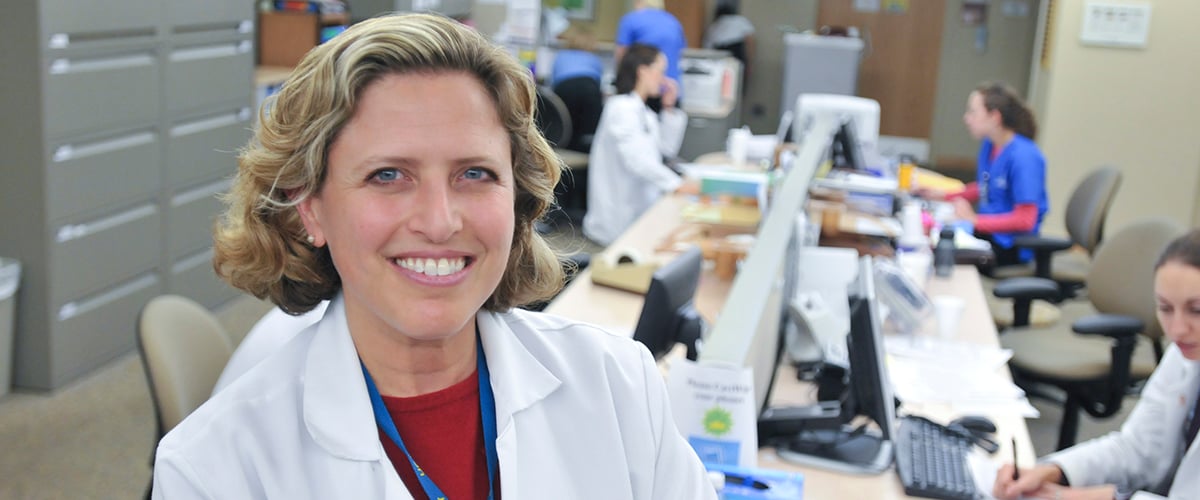 Jean Kutner, MD, is one of the leaders of the Data Science to Patient Value initiative
Jean Kutner, MD, is one of the leaders of the Data Science to Patient Value initiative
When Jean Kutner, MD, MSPH, provides care for patients, she wishes she could spend more time talking with patients about their health and the care they want to receive—and not spending her time on a computer, trying to sort through volumes of health records.
“That’s probably not a good use of our valuable and limited time together,” said Kutner, a general internist and palliative care specialist, chief medical officer of University of Colorado Hospital and associate dean for clinical affairs at the University of Colorado School of Medicine (SOM).
Despite her occasional frustration, Kutner is not against technology—far from it. She wants to unlock its potential to create effective care personalized for each patient.
Kutner co-leads the Data Science to Patient Value (D2V) initiative, a new multidisciplinary program at the University of Colorado Anschutz Medical Campus. The initiative, supported with a $20 million grant from the SOM’s Transformational Research Funding program, has big ambitions.
“Our work could revolutionize how we think about how health care is provided, the patient experience, and how we make decisions,” Kutner said. “Our goal is to make CU Anschutz a leader in the intersection between data and value and the application of cutting-edge data science to the value equation.”
Personalizing big data
Right now, the volume of clinically relevant data in health records and from other sources can be overwhelming. Initiatives like D2V could fix that and develop technologies that create a new era in health care. Kutner thinks in the future supercomputers will help diagnose and treat patients, and that will lead to real improvements in their health and maximize the doctor-patient relationship.
“This is personalized medicine focused on a patient’s goals and values, and not necessarily on their genome,” Kutner said.
She gives the hypothetical example of a patient just discharged from the hospital. In a few years, a doctor could use an activity tracker like a Fitbit to see if the patient exercises and gets out of the house. The doctor would look for signs the patient is not recovering or has developed other health problems.
Kutner said the clinical team could see the data and reach out to the patient, checking on their status and, if necessary, asking the patient to come in to be evaluated. Before the visit, a supercomputer could analyze the patient’s data and compare it to data collected from tens of millions of other people. The analysis could create a personalized risk profile with suggestions for a custom treatment plan based on proven therapies. At the start of the next appointment, a doctor could see that information in single user-friendly dashboard.
“With all that data already synthesized, I could get the most value out of face-to-face time with a patient and help them make decisions about their treatment,” Kutner said. “That would be my ideal world.”
Physicians would still have important roles, Kutner said. The doctor and patient would use their time together to talk about what problems are arising and focus on their patients’ priorities. They would work together to get back on track.
Value from the patient’s perspective
While D2V is working on technological innovation in fields such as medical informatics, biostatistics and data visualization, Kutner said it also will address the more philosophical question of how to define value. It is not a simple question.
“If I’m a patient, I might define value differently than an insurer or a health care provider,” Kutner said. Patients can have unsatisfactory experiences despite being what doctors might consider success stories.
D2V will address that disconnect by including stakeholders such as patient advocates and experts in public health and the insurance industry. Kutner believes that will keep the project focused on the ultimate goal, which is improving care.
Building technology and a team
D2V started work in 2016 by recruiting experts from across CU Anschutz. Kutner wants to take advantage of CU Anschutz’s collaborative environment and current faculty members, researchers and staff.
“We have unique expertise here. We have outstanding data scientists. We have people who do world-leading work in care decision making and understanding stakeholder perspectives,” Kutner said. “We need to connect them behind a common goal.”
D2V also recruits researchers from around the world, with more people hired each month. Guest speakers from other leading institutions have given seminars to spark ideas.
Eight pilot projects are underway. They include a team trying to improve the databases that track children who have severe asthma attacks. That project’s goal is to test whether risk profiles can help create personalized predictions of when children might suffer attacks.
D2V will fund an additional six pilot projects in 2017 and is accepting project proposals through March 15.
